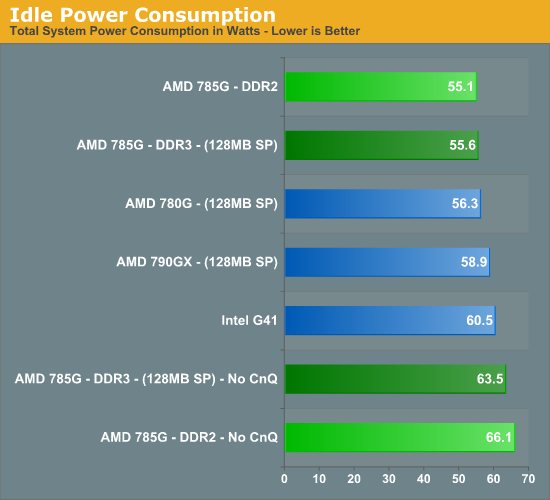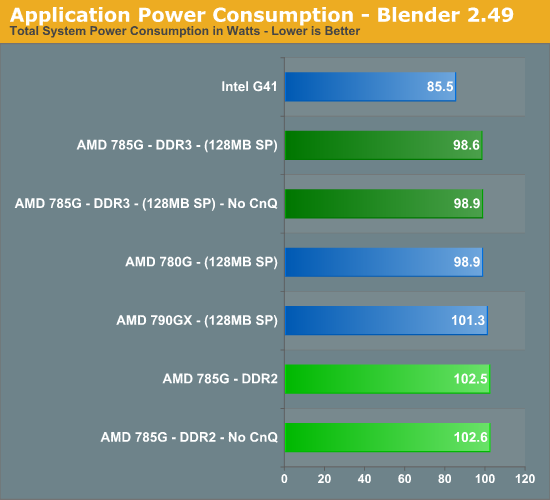AMD's 785G Chipset - Revolutionary or Evolutionary?
by Gary Key on August 4, 2009 5:00 AM EST- Posted in
- Motherboards
Power Consumption testing on the AMD platforms is always a hit or miss event. Either all the stars are aligned, more like the BIOS and driver sets are matched perfectly, or we enter the black hole known simply as Cool-n-Quiet. We had more problems getting CnQ to work properly on our early review samples than California does getting a balanced budget in place. Honestly, we have to wonder just how hard it can be to get the BIOS code in this area to stay consistent.
The reason we mention this is that just about every board had a problem with it. The first BIOS works but something else needs tuning, the second BIOS breaks CnQ, then the third fixes it, and the fourth revision breaks it again. On and on it went until Friday when not only did solid BIOS releases appear but also drivers that matched up with them.
That said, AMD has made further improvements in the PowerPlay technology utilized on the 785G. The stream processors normally run at 500MHz under full load, but PowerPlay now constantly adjusts clock speeds based on GPU utilization rates. In fact, the core will scale down to 60MHz when idling. In addition, the internal clocks inside the 785G will scale dynamically to save power regardless of voltage settings.
We have already looked at power consumption in individual tests. This time we are measuring total system power consumption, except for the monitor and A/V equipment, at the wall using a Watts Up Pro power meter. Our results were taken at idle and while rendering a large scene with Blender 2.49 x64. We measured with all power management options enabled except on the AMD systems were we also list “No CnQ” results. Windows 7 is set to balanced mode in all of our tests.
Our Gigabyte 785G DDR2 board required that we set CoreVid manually as it would default to 1.392V with our Athlon II X2 250 processor instead of 1.315V. We set voltage to 1.350V, which resulted in a true reading of 1.332V, still higher than default. This will affect the load numbers as CnQ properly set idle voltages to 0.920V.


In the idle test, both of the 785G boards pull the fewest watts. The G41 looks like a gas guzzler compared to the other boards although an idle rate of 60.5W is nothing to get upset about. Once CnQ is disabled, the 785G boards draw about 18% more energy on average.
The tables are turned in the load test. The Intel G41 system is 4% slower in performance in this title compared to the AMD 785G platforms, but uses 14% less energy coming across the finish line. You can either take the energy savings and wait a little longer or get the task over with sooner depending on your work habits. We prefer less time but do not want another iceberg lecture from Al Gore.










43 Comments
View All Comments
Hrel - Saturday, August 22, 2009 - link
You showed Nvidia stats on the first page... I guess you didn't include them cause ATI and Intel can't even compare???Next time include the Nvidia results... would've thought that it'd an impulsory action; guess not.
crochat - Tuesday, August 18, 2009 - link
Gary,You mentioned a motherboard roundup in your conclusion. I thought it would come sooner.
Regards
AlB80 - Sunday, August 16, 2009 - link
1. The A-Link Express II is a proprietary interface developed by AMD basing on the PCI Express Gen2 version 2.0 technology, with additional Northbridge-Southbridge messaging functionalities.2. High data transfer bandwidth (up to 2.5 Gb/s / Lane)
Concillian - Saturday, August 15, 2009 - link
"Remember when ATI made crappy chipsets that no one bought, and all AMD systems were built with NVIDIA or even VIA chipsets? "Yeah, I remember that, thats when they were really AMD chipsets and not ATi chipsets with an AMD label on them. ATi started making good Crossfire chipsets shortly before AMD bought them.
I like AMD as much as the next guy, but let's not be patting them on the back too hard. They tried, failed, then did what any good American businessman would do... bought a struggling competitor to use their IP.
IntelUser2000 - Saturday, August 8, 2009 - link
Gary, you got the clock speed of the G41 IGP wrong:http://www.techarp.com/showarticle.aspx?artno=543&...">http://www.techarp.com/showarticle.aspx?artno=543&...
G41 and G43 uses a 667MHz core while G45 uses 800MHz.
Notice the differences here: http://global.hkepc.com/1525/page/3#view">http://global.hkepc.com/1525/page/3#view
ClagMaster - Saturday, August 8, 2009 - link
The 785G is just a 780G which has recieved a fine tuning. Which is OK. There are slight improvements in performance over the 780G but nothing to be excited about. 785G Seems to work well with DDR3 memory and Athlon II processors.I have an ASUS M3A78EM 780G Mobo with an AMD BE2400 X2 CPU I use as a secondary computer I keep off-line for private matters. It's a fairly powerful rig for the media applications I run.
The HD 3200 GPU is just as powerful as a Geforce 4200 graphics card. I can play DX8 and DX9 games from the 2002-2004 period (Max Payne, Aquanox, Homeworld2) with acceptable framerates at 1280 x 1024 resolution. I run Windows XP Home.
The 785G is not bad. But if I had a choice between a 785G mobo and a 780G mobo with the 780G costing $5-$10 less, I would buy the 780G mobo. I can still run Windows 7 with the 780G with the HD3200.
ClagMaster - Saturday, August 8, 2009 - link
BTW-This article was not boring. It honestly compared the performance capabilities of the 785G to other chipsets of its class (780G and G41).
Most differences between the 785G and 780G were small and within the combined statistical uncertainty of the benchmark measurements measurements +/-10% (i.e. statistically insignificant). Not very surprising. Most of the larger differences observed were between systems with DDR2-1066 and DDR3-1333 memory systems.
I agree the 785G is a better balanced chipset than the 780G and G41 for multimedia.
I wish Gary would have used an older benchmarking suite so I can compare the performance between current and systems 2-3 years old. I prefer PCMark2005 and 3DMark2005 since these are reliable indicators of performance. This is important to me because I try to make my purchasing decisions on the criteria of having double the performance for the same cost and power consumption.
ClagMaster - Saturday, August 8, 2009 - link
BTW-This article was not boring. It honestly compared the performance capabilities of the 785G to other chipsets of its class (780G and G41).
Most differences between the 785G and 780G were small and within the combined statistical uncertainty of the benchmark measurements measurements +/-10% (i.e. statistically insignificant). Not very surprising. Most of the larger differences observed were between systems with DDR2-1066 and DDR3-1333 memory systems.
I agree the 785G is a better balanced chipset than the 780G and G41 for multimedia.
I wish Gary would have used an older benchmarking suite so I can compare the performance between current and systems 2-3 years old. I prefer PCMark2005 and 3DMark2005 since these are reliable indicators of performance. This is important to me because I try to make my purchasing decisions on the criteria of having double the performance for the same cost and power consumption.
7Enigma - Thursday, August 6, 2009 - link
Gary,Thanks for the article but could you keep in mind for future articles on non-gaming hardware (i.e. IG's, budget GPU's, etc.) to make sure the game description is in line with the actual article? I can tell they were just copied directly from a previous gaming article, so it's a bit silly to see, "We crank up all the details to max", only to see the data chart show 1024X768 with low settings.
:)
AlB80 - Wednesday, August 5, 2009 - link
DMI 10Gb/s each direction, full duplexaka
4 lane PCIe 1.1